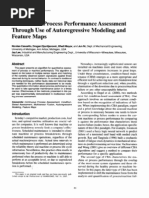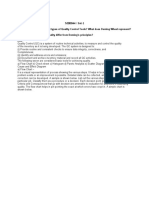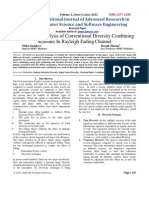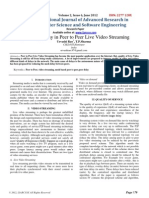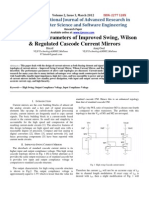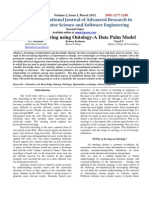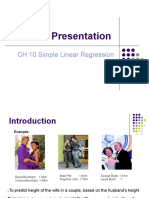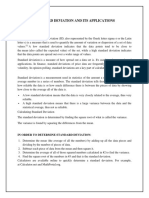A Comparative Study of Software Reliability Models Using SPC On Ungrouped Data
A Comparative Study of Software Reliability Models Using SPC On Ungrouped Data
Uploaded by
editor_ijarcsseCopyright:
Available Formats
A Comparative Study of Software Reliability Models Using SPC On Ungrouped Data
A Comparative Study of Software Reliability Models Using SPC On Ungrouped Data
Uploaded by
editor_ijarcsseOriginal Title
Copyright
Available Formats
Share this document
Did you find this document useful?
Is this content inappropriate?
Copyright:
Available Formats
A Comparative Study of Software Reliability Models Using SPC On Ungrouped Data
A Comparative Study of Software Reliability Models Using SPC On Ungrouped Data
Uploaded by
editor_ijarcsseCopyright:
Available Formats
Volume 2, Issue 2, February 2012 ISSN: 2277 128X
International Journal of Advanced Research in
Computer Science and Software Engineering
Research Paper
Available online at: www.ijarcsse.com
A Comparative Study of Software Reliability Models Using
SPC on Ungrouped Data
G.Krishna Mohan
Reader,
Dept. of Computer Science
P.B.Siddhartha college
Vijayawada.
km_mm_2000@yahoo.com
B. Srinivasa Rao
Associate Professor
Dept. of Compute Science
VRS & YRN College
Chirala
sreenibandla@yahoo.com
Dr. R.Satya Prasad
Associate Professor
Dept. of CS&E.
Acharya Nagrjuna University
Nagarjuna Nagar.
profrsp@gmail.com
AbstractControl charts are widely used for process monitoring. Software reliability process can be monitored efficiently by using
Statistical Process Control (SPC). It assists the software development team to identify failures and actions to be taken during software
failure process and hence, assures better software reliability. If not many, few researchers proposed SPC based software reliability
monitoring techniques to improve Software Reliability Process. In this paper we propose a control mechanism based on the
cumulative quantity between observations of time domain failure data using mean value function of Weibull and Goel-Okumoto
distribution, which are based on Non Homogenous Poisson Process (NHPP). The Maximum Likelihood Estimation (MLE) method is
used to derive the point estimators of the distributions.
Keywords Statistical Process Control, Software reliability, Weibull Distribution, Goel-Okumoto distribution, Mean Value function,
Probability limits, Control Charts.
I. INTRODUCTION
Software reliability assessment is important to evaluate and
predict the reliability and performance of software system,
since it is the main attribute of software. To identify and
eliminate human errors in software development process and
also to improve software reliability, the Statistical Process
Control concepts and methods are the best choice. SPC
concepts and methods are used to monitor the performance of
a software process over time in order to verify that the process
remains in the state of statistical control. It helps in finding
assignable causes, long term improvements in the software
process. Software quality and reliability can be achieved by
eliminating the causes or improving the software process or its
operating procedures [1].
The most popular technique for maintaining process control
is control charting. The control chart is one of the seven tools
for quality control. Software process control is used to secure
the quality of the final product which will conform to
predefined standards. In any process, regardless of how
carefully it is maintained, a certain amount of natural
variability will always exist. A process is said to be
statistically in-control when it operates with only chance
causes of variation. On the other hand, when assignable
causes are present, then we say that the process is statistically
out-of-control.
The control charts can be classified into several categories,
as per several distinct criteria. Depending on the number of
quality characteristics under investigation, charts can be
divided into univariate control charts and multivariate control
charts. Furthermore, the quality characteristic of interest may
be a continuous random variable or alternatively a discrete
attribute. Control charts should be capable to create an alarm
when a shift in the level of one or more parameters of the
underlying distribution or a non-random behavior occurs.
Normally, such a situation will be reflected in the control
chart by points plotted outside the control limits or by the
presence of specific patterns. The most common non-random
patterns are cycles, trends, mixtures and stratification [2]. For
a process to be in control the control chart should not have any
trend or nonrandom pattern.
SPC is a powerful tool to optimize the amount of
information needed for use in making management decisions.
Statistical techniques provide an understanding of the business
Volume 2, issue 2, February 2012 www.ijarcsse.com
2012, IJARCSSE All Rights Reserved
baselines, insights for process improvements, communication
of value and results of processes, and active and visible
involvement. SPC provides real time analysis to establish
controllable process baselines; learn, set, and dynamically
improves process capabilities; and focus business areas which
need improvement. The early detection of software failures
will improve the software reliability. The selection of proper
SPC charts is essential to effective statistical process control
implementation and use. The SPC chart selection is based on
data, situation and need [3]. Many factors influence the
process, resulting in variability. The causes of process
variability can be broadly classified into two categories, viz.,
assignable causes and chance causes.
The control limits can then be utilized to monitor the failure
times of components. After each failure, the time can be
plotted on the chart. If the plotted point falls between the
calculated control limits, it indicates that the process is in the
state of statistical control and no action is warranted. If the
point falls above the UCL, it indicates that the process average,
or the failure occurrence rate, may have decreased which
results in an increase in the time between failures. This is an
important indication of possible process improvement. If this
happens, the management should look for possible causes for
this improvement and if the causes are discovered then action
should be taken to maintain them. If the plotted point falls
below the LCL, It indicates that the process average, or the
failure occurrence rate, may have increased which results in a
decrease in the failure time. This means that process may have
deteriorated and thus actions should be taken to identify and
the causes may be removed. It can be noted here that the
parameter a, b should normally be estimated with the data
from the failure process. Since a, b are the parameters in the
proposed distributions, any traditional estimator can be used.
The control limits for the chart are defined in such a
manner that the process is considered to be out of control
when the time to observe exactly one failure is less than LCL
or greater than UCL. Our aim is to monitor the failure process
and detect any change of the intensity parameter. When the
process is normal, there is a chance for this to happen and it is
commonly known as false alarm. The traditional false alarm
probability is to set to be 0.27% although any other false
alarm probability can be used. The actual acceptable false
alarm probability should in fact depend on the actual product
or process [9].
II. LITERATURE SURVEY
This section presents the theory that underlies the proposed
distributions and maximum likelihood estimation for complete
data. If t is a continuous random variable with
pdf:
1 2
( ; , , , )
k
f t u u u . Where
1 2
, , ,
k
u u u are k unknown
constant parameters which need to be estimated, and cdf:
( ) F t . Where, The mathematical relationship between the
pdf and cdf is given by:
( ) ( )
( )
d F t
f t
dt
= . Let a denote the
expected number of faults that would be detected given
infinite testing time in case of finite failure NHPP models.
Then, the mean value function of the finite failure NHPP
models can be written as: ( ) ( ) m t aF t = . where, F(t) is a
cumulative distribution function. The failure intensity function
( ) t in case of the finite failure NHPP models is given by:
( ) '( ) t aF t = [8].
A. NHPP model
The Non-Homogenous Poisson Process (NHPP) based
software reliability growth models (SRGMs) are proved to be
quite successful in practical software reliability engineering
[4]. The main issue in the NHPP model is to determine an
appropriate mean value function to denote the expected
number of failures experienced up to a certain time point.
Model parameters can be estimated by using Maximum
Likelihood Estimate (MLE). Various NHPP SRGMs have
been built upon various assumptions. Many of the SRGMs
assume that each time a failure occurs, the fault that caused it
can be immediately removed and no new faults are introduced.
Which is usually called perfect debugging. Imperfect
debugging models have proposed a relaxation of the above
assumption [5,6].
Let ( ) { }
, 0 N t t > be the cumulative number of software
failures by time t. m(t) is the mean value function,
representing the expected number of software failures by time
t. ( ) t is the failure intensity function, which is
proportional to the residual fault content. Thus
( ) (1 )
bt
m t a e
= and
( )
( )
( ( ))
dm t
t b a m t
dt
= =
.
where a denotes the initial number of faults contained in a
program and b represents the fault detection rate. In software
reliability, the initial number of faults and the fault detection
rate are always unknown. The maximum likelihood technique
can be used to evaluate the unknown parameters. In NHPP
SRGM ( ) t can be expressed in a more general way as
( ) ( ) ( ) ( )
( ) dm t
t b t a t m t
dt
= = (
. where ( ) a t is the time-
dependent fault content function which includes the initial and
introduced faults in the program and ( ) b t is the time-
dependent fault detection rate. A constant ( ) a t implies the
perfect debugging assumption, i.e no new faults are
introduced during the debugging process. A constant ( ) b t
implies the imperfect debugging assumption, i.e when the
faults are removed, then there is a possibility to introduce new
faults.
B. Goel-Okumoto distribution
The Goel-Okumoto model is a simple NonHomogenous
Poisson Process (NHPP) model with the mean value function
( ) ( ) 1
bt
m t a e
=
[12]. Where the parameter a is the
number of initial faults in the software and the parameter b
is the fault detection rate. The corresponding failure intensity
Volume 2, issue 2, February 2012 www.ijarcsse.com
2012, IJARCSSE All Rights Reserved
function is given by
( )
bt
t abe
=
. The probability density
function of a Goel-Okumoto model has the form:
( )
bt
f t be
= . The corresponding cumulative distribution
function is: ( ) 1
bt
F t e
= .
C. Weibull distribution
The Weibull distribution is a generalization of exponential
distribution, which is recovered for = 1. Although the
exponential distribution has been widely used for times-
between-event, Weibull distribution is more suitable as it is
more flexible and is able to deal with different types of aging
phenomenon in reliability. Hence in reliability monitoring of
equipment failures, the Weibull distribution is a good
alternative. The probability density function of a two-
parameter Weibull model has the form:
( )
( )
1
( )
bt
f t b bt e
|
|
|
= . Where b > 0 is a scale parameter
and 0 | > is a shape parameter. The corresponding
cumulative distribution function is: ( )
( )
1
bt
F t e
|
= . The
mean value function
( )
( ) 1
n
bt
m t a e
|
(
=
(
. The failure
intensity function is given as:
1 ( )
( ) .
bt
t ab t e
|
| |
|
= .
D. MLE (Maximum Likelihood) Parameter Estimation
The idea behind maximum likelihood parameter estimation
is to determine the parameters that maximize the probability
(likelihood) of the sample data. The method of maximum
likelihood is considered to be more robust (with some
exceptions) and yields estimators with good statistical
properties. In other words, MLE methods are versatile and
apply to many models and to different types of data. Although
the methodology for maximum likelihood estimation is simple,
the implementation is mathematically intense. Using today's
computer power, however, mathematical complexity is not a
big obstacle. If we conduct an experiment and obtain N
independent observations,
1 2
, , ,
N
t t t . The likelihood
function [7] may be given by the following product:
( )
1 2 1 2 1 2
1
, , , | , , , ( ; , , , )
N
N k i k
i
L t t t f t u u u u u u
=
=
[
Likely hood function by using (t) is:
1
( )
n
i
i
L t
=
=
[
The logarithmic likelihood function is given by:
| |
1
1
log log ( )
log ( ) ( )
n
i
i
n
i n
i
L t
t m t
=
=
| |
=
|
\ .
=
[
The maximum likelihood estimators (MLE) of
1 2
, , ,
k
u u u are obtained by maximizing L or A, where Ais
ln L . By maximizing , which is much easier to work with
than L, the maximum likelihood estimators (MLE) of
1 2
, , ,
k
u u u are the simultaneous solutions of k equations
such as:
( )
0
j
u
c A
=
c
, j=1,2,,k
The parameters a and b are estimated as follows. The
parameter b is estimated by iterative Newton Raphson
Method using
1
( )
'( )
n
n n
n
g b
b b
g b
+
=
, which is substituted in
finding a.
III. ILLUSTRATING THE MLE METHOD
A. Goel-Okumoto parameter estimation
The likelihood function is given as, ( )
1
N
bt
i
L abe
=
=
[
Taking the natural logarithm on both sides, The Log
Likelihood function is given as:
( ) ( )
1
log log( ) [1 ]
i n
n
bt bt
i
L abe a e
=
=
.
Taking the Partial derivative with respect to a and
equating to 0. (i.e
log
0
L
a
c
=
c
).
( )
1
n
bt
n
a
e
=
(
Taking the Partial derivative with respect to b and
equating to0.(i.e
log
( ) 0
L
g b
b
c
= =
c
).
( )
( )
( )
1
( ) 0
1
n
n
bt
n
i n
bt
i
n e
g b t nt
b
e
=
= + =
Taking the partial derivative again with respect to b and
equating to 0. (i.e
2
2
log
'( ) 0
L
g b
b
c
= =
c
).
( )
( )
( )
( )
( )
2
2 2
1
'( )
1
1
n
n
n
n
bt
bt
n
bt
bt
n e
g b nt e
b
e
e
= +
`
)
B. Weibull parameter estimation
The likelihood function, assuming 2 | = (Rayleigh) is
given as,
2
2 ( )
1
2 .
N
bt
i
L ab t e
=
=
[
Taking the natural logarithm on both sides, The Log
Likelihood function is given as:
2 2
( ) 2 ( )
1
log log(2 ) [1 ]
n
n
bt bt
i
i
L ab t e a e
=
=
.
Taking the Partial derivative with respect to a and
equating to 0. (i.e
log
0
L
a
c
=
c
).
( )
2
1
n
bt
n
a
e
=
(
(
Taking the Partial derivative with respect to b and
equating to0.(i.e
log
( ) 0
L
g b
b
c
= =
c
).
( )
( )
( )
2
2
2
2
1
2. . . . 2
( ) 2 0
1
n
n
bt
n
n
i
bt
i
nbt e n
g b b t
b
e
=
= =
Volume 2, issue 2, February 2012 www.ijarcsse.com
2012, IJARCSSE All Rights Reserved
Taking the partial derivative again with respect to b and
equating to 0. (i.e
2
2
log
'( ) 0
L
g b
b
c
= =
c
).
( )
( )
( )
( )
( )
( )
2 2
2
2
2 2
2 2
2 2
1
2 . 1
'( ) 2 2 2
1
1
n n
n
n
bt bt
n
n
i n
bt
bt
i
b t e e
g b n t nt
b
e
e
=
| |
=
`
|
\ .
C. Distribution of Time between failures
Based on the inter failure data given in Table 1, we
compute the software failures process through Mean Value
Control chart. We used cumulative time between failures data
for software reliability monitoring using Goel-Okumoto and
Weibull distributions. The use of cumulative quality is a
different and new approach, which is of particular advantage
in reliability.
a
.
and b
.
are Maximum Likely hood Estimates of
parameters and the values can be computed using iterative
method for the given cumulative time between failures data
[10] shown in table 1. Using a and b values we can
compute ( ) m t .
TABLE 1. TIME BETWEEN FAILURES OF A SOFTWARE
Failure
Number
Time
between
failure(h)
Failure
Number
Time
between
failure(h)
1 30.02 16 15.53
2 1.44 17 25.72
3 22.47 18 2.79
4 1.36 19 1.92
5 3.43 20 4.13
6 13.2 21 70.47
7 5.15 22 17.07
8 3.83 23 3.99
9 21 24 176.06
10 12.97 25 81.07
11 0.47 26 2.27
12 6.23 27 15.63
13 3.39 28 120.78
14 9.11 29 30.81
15 2.18 30 34.19
Assuming an acceptable probability of false alarm of 0.27%,
the control limits can be obtained as [10]:
( )
1 0.99865
bt
U
T e
|
= =
( )
1 0.5
bt
C
T e
|
= =
( )
1 0.00135
bt
L
T e
|
= =
These limits are converted to ( )
U
m t , ( )
C
m t and ( )
L
m t
form. They are used to find whether the software process is in
control or not by placing the points in Mean value chart
shown in figure 1 and figure 2. A point below the control limit
( )
L
m t indicates an alarming signal. A point above the
control limit ( )
U
m t indicates better quality. If the points are
falling within the control limits, it indicates the software
process is in stable condition [11]. The values of parameter
estimates and the control limits are given in table 2 and 3
respectively.
TABLE 2. PARAMETER ESTIMATES
model a b
GO 31.698171 0.003962
Weibull 30.051592 0.003416
TABLE 3. CONTROL LIMITS.
model
) (
U
t m
) (
C
t m
) (
L
t m
GO 31.676760 21.132114 0.085469
Weibull 30.011170 15.025870 0.040570
TABLE 4. MEAN SUCCESSIVE DIFFERENCES OF GO
FN m(t) SD
1 3.554578 0.160101
2 3.714687 2.383587
3 6.098274 0.137569
4 6.235844 0.343684
5 6.579527 1.279946
6 7.859432 0.481484
7 8.340916 0.351758
8 8.692674 1.836638
9 10.529312 1.060330
10 11.589642 0.037410
11 11.627052 0.489356
12 12.116408 0.261248
13 12.377656 0.684916
14 13.062573 0.160266
15 13.222838 1.102518
16 14.325356 1.683122
17 16.008478 0.172479
18 13.180956 0.117592
19 16.298549 0.249935
20 16.548483 3.690661
21 20.239144 0.749363
22 20.988508 0.167971
23 21.156479 5.293999
24 26.450479 1.441653
25 27.892132 0.034077
26 27.926209 0.226497
27 28.152706 1.348363
28 29.501069 0.252475
29 29.753545 0.246358
30 29.999903
TABLE 5. MEAN SUCCESSIVE DIFFERENCES OF WEIBULL
FN m(t) SD
1 0.314371 0.030704
2 0.345076 0.657725
3 1.002801 0.050307
4 1.053108 0.132025
5 1.185134 0.575065
6 1.760199 0.252180
7 2.012380 0.197261
8 2.209641 1.219663
Volume 2, issue 2, February 2012 www.ijarcsse.com
2012, IJARCSSE All Rights Reserved
9 3.429305 0.859242
10 4.288547 0.032507
11 4.321054 0.439360
12 4.760415 0.245447
13 5.005863 0.680255
14 5.686118 0.166975
15 5.853094 1.230688
16 7.083782 2.161267
17 9.245050 0.240957
18 9.486008 0.166350
19 9.652358 0.359124
20 10.011482 6.120127
21 16.131610 1.396357
22 17.527968 0.317624
23 17.845592 9.491850
24 27.337443 1.649185
25 28.986628 0.029822
26 29.016451 0.186649
27 29.203101 0.697874
28 29.900976 0.058849
29 29.959825 0.040168
30 29.999994
Figure 1 and 2 are obtained by placing the time between
failures cumulative data shown in tables 3, 4 on y axis and
failure number on x axis, and the values of control limits are
placed on Mean Value chart. The Mean Value chart of Goel-
Okumoto shows that the 10
th
and 25
th
failure data has fallen
below ( )
L
m t . The Mean Value chart of weibull shows that
the 1
st
,10
th
and 25
th
failure data has fallen below ( )
L
m t . The
successive differences of mean values below ( )
L
m t indicates
the failure process. In the present scenario, It is significantly
early detection of failure through weibull using Mean Value
Chart. The software quality is determined by detecting failures
at an early stage. The Remaining Failure data shown in figure
1 are in stable condition. No failure data fall outside
the ( )
U
m t . It does not indicate any alarm signal.
Failure Control Chart
UCL=31.676760
CL=21.132114
LCL=0.085469
0.010000
0.100000
1.000000
10.000000
100.000000
1 3 5 7 9 11 13 15 17 19 21 23 25 27 29
Failure Number
M
e
a
n
V
a
l
u
e
S
u
c
c
e
s
s
i
v
e
D
i
f
f
e
r
e
n
c
e
s
Figure: 1 GO Failure Control Chart
Mean Value Chart
UCL=30.011022
CL=15.025796
LCL=0.040570
0.010000
0.100000
1.000000
10.000000
100.000000
1 3 5 7 9 11 13 15 17 19 21 23 25 27 29
Failure Number
M
e
a
n
V
a
l
u
e
S
u
c
c
e
s
s
i
v
e
D
i
f
f
e
r
e
n
c
e
s
Figure: 2 Weibull Mean Value Chart
IV. CONCLUSION
The given 30 inter failure times are plotted through the
estimated mean value function against the failure serial order.
The parameter estimation is carried out by Newton Raphson
Iterative method for the models. The graphs have shown out
of control signals i.e below the LCL. Hence we conclude that
our method of estimation and the control chart are giving a
+ve recommendation for their use in finding out preferable
control process or desirable out of control signal. By
observing the Mean value Control chart we identified that the
failure situation is detected at 10th and 25th point of table-4,
1st ,10th, 25th and 29th point of table-5 i.e ailure data has
fallen below ( )
L
m t . The successive difference of mean
values below ( )
L
m t indicates the failure process. In the
present scenario, It is significantly early detection of failure
through weibull using Mean Value Chart. The software
quality is determined by detecting failures at an early stage for
the corresponding ( ) m t , which is below ( )
L
m t . It indicates
that the failure process is detected at an early stage compared
with Xie et. a1 (2002) control chart [10], which detects the
failure at 23rd point for the inter failure data above the UCL.
Hence our proposed Mean Value Chart detects out of control
situation at an earlier than the situation in the time control
chart. The early detection of software failure will improve the
software Reliability. When the time between failures is less
than LCL, it is likely that there are assignable causes leading
to significant process deterioration and it should be
investigated. On the other hand, when the time between
failures has exceeded the UCL, there are probably reasons that
have lead to significant improvement.
REFERENCES
[1] Kimura, M., Yamada, S., Osaki, S., 1995. Statistical Software
reliability prediction and its applicability based on mean time between
failures. Mathematical and Computer Modeling Volume 22, Issues
10-12, Pages 149-155.
[2] Koutras, M.V., Bersimis, S., Maravelakis,P.E., 2007. Statistical
process control using shewart control charts with supplementary Runs
rules Springer Science + Business media 9:207-224.
[3] MacGregor, J.F., Kourti, T., 1995. Statistical process control of
multivariate processes. Control Engineering Practice Volume 3, Issue
3, March 1995, Pages 403-414 .
[4] Musa, J.D., Iannino, A., Okumoto, k., 1987. Software Reliability:
Measurement Prediction Application. McGraw-Hill, New York.
[5] Ohba, M., 1984. Software reliability analysis model. IBM J. Res.
Develop. 28, 428-443.
Volume 2, issue 2, February 2012 www.ijarcsse.com
2012, IJARCSSE All Rights Reserved
[6] Pham. H., 1993. Software reliability assessment: Imperfect debugging
and multiple failure types in software development. EG&G-RAAM-
10737; Idaho National Engineering Laboratory.
[7] Pham. H., 2003. Handbook Of Reliability Engineering, Springer.
[8] Pham. H., 2006. System software reliability, Springer.
[9] Swapna S. Gokhale and Kishore S.Trivedi, 1998. Log-Logistic
Software Reliability Growth Model. The 3rd IEEE International
Symposium on High-Assurance Systems Engineering. IEEE Computer
Society.
[10] Xie, M., Goh. T.N., Ranjan.P., Some effective control chart
procedures for reliability monitoring -Reliability engineering and
System Safety 77 143 -150 2002.
[11] Satya Prasad, R., Half logistic distribution for software reliability
growth model, Ph.D thesis, 2007.
Goel, A.L., Okumoto, K., 1979. Time-dependent errordetection rate model for
software reliability and other performance measures. IEEE Trans. Reliab. R-
28, 206-211.
AUTHOR PROFILE:
FIRST AUTHOR:
G. Krishna Mohan is working as a Reader in
the Department of Computer Science,
P.B.Siddhartha College, Vijayawada. He
obtained his M.C.A degree from Acharya
Nagarjuna University in 2000, M.Tech from
JNTU, Kakinada, M.Phil from Madurai
Kamaraj University and pursuing Ph.D at
Acharya Nagarjuna University. His research interests lies in
Data Mining and Software Engineering. He has published
several research papers in National and International Journals.
SECOND AUTHOR:
B. Srinivasa rao received the Master Degree in
Computer Science and Engineering from Dr
MGR Deemed University, Chennai, Tamil
Nadu, India. He is Currently working as
Associate Professor in PG Department of
Computer Applications, VRS & YRN
College, Chirala, Andhra Pradesh, India. His research interests
include software reliability, Cryptography and Computer
Networks. He has published several papers in National and
International Journals.
THIRD AUTHOR:
Dr. R. Satya Prasad received Ph.D. degree in
Computer Science in the faculty of
Engineering in 2007 from Acharya Nagarjuna
University, Andhra Pradesh. He received gold
medal from Acharya Nagarjuna University for
his outstanding performance in Masters
Degree. He is currently working as Associate
Professor and H.O.D, in the Department of Computer Science
& Engineering, Acharya Nagarjuna University. His current
research is focused on Software Engineering. He has published
several papers in National & International Journals.
You might also like
- Standard Operating Procedure: A Process Failure Mode Effects Analysis (PFMEA)Document2 pagesStandard Operating Procedure: A Process Failure Mode Effects Analysis (PFMEA)Nikhil Singla0% (1)
- Two Step Approach For Software Process Control: HLSRGMDocument7 pagesTwo Step Approach For Software Process Control: HLSRGMInternational Journal of Application or Innovation in Engineering & ManagementNo ratings yet
- Statistical Quality ControlDocument23 pagesStatistical Quality Controljoan dueroNo ratings yet
- Implementation of SPC Techniques in Automotive Industry: A Case StudyDocument15 pagesImplementation of SPC Techniques in Automotive Industry: A Case StudysushmaxNo ratings yet
- Herramientas para Conservar y Mejorar La Conversion EsbeltaDocument34 pagesHerramientas para Conservar y Mejorar La Conversion Esbeltafranckiko3No ratings yet
- SQC and TQM TutorialDocument8 pagesSQC and TQM Tutorialtadesse fissehaNo ratings yet
- Certification Course On Quality Assurance and Statistical Quality Techniques Course Level A Statistical Process Control Concepts & Control ChartsDocument28 pagesCertification Course On Quality Assurance and Statistical Quality Techniques Course Level A Statistical Process Control Concepts & Control Chartsrchandra2473No ratings yet
- Statistical Process ControlDocument14 pagesStatistical Process Controlprince198No ratings yet
- Quality Engineering and Management System Accounting EssayDocument12 pagesQuality Engineering and Management System Accounting EssayvasudhaaaaaNo ratings yet
- LCE Line Performance OptimizationDocument2 pagesLCE Line Performance OptimizationAnthony CollierNo ratings yet
- ProjectQuality-modified CompressedDocument60 pagesProjectQuality-modified CompressedAnupam BongaleNo ratings yet
- Study On The Estimation of Process Capability For A LatheDocument41 pagesStudy On The Estimation of Process Capability For A Latheakshat naiduNo ratings yet
- Om II Unit III NotesDocument36 pagesOm II Unit III NotesAmruta PeriNo ratings yet
- Principles of Six Sigma PDFDocument10 pagesPrinciples of Six Sigma PDFFerigrina ChanNo ratings yet
- Quality Management, Part 2: Monday, November 21, 2011 4:50 PMDocument11 pagesQuality Management, Part 2: Monday, November 21, 2011 4:50 PMAsif AhmedNo ratings yet
- Manufacturing Technology AssignmentDocument15 pagesManufacturing Technology AssignmentDan Kiama MuriithiNo ratings yet
- Statistical Process Control For Quality ImprovementDocument8 pagesStatistical Process Control For Quality ImprovementAhmed IsmailNo ratings yet
- 7 Quality Control ToolsDocument3 pages7 Quality Control ToolsRumitPanchal0% (1)
- Simulation Study of Average Run Lengths in Statistical Process ControlDocument23 pagesSimulation Study of Average Run Lengths in Statistical Process ControlMohammed FadelNo ratings yet
- CoatingDocument23 pagesCoatingPutra GunawanNo ratings yet
- Assignment 3Document9 pagesAssignment 3api-265324689No ratings yet
- SPC in Communication EngineeringDocument12 pagesSPC in Communication EngineeringHusaini BaharinNo ratings yet
- Optimum Control Limits For Employing Statistical Process Control in Software ProcessDocument9 pagesOptimum Control Limits For Employing Statistical Process Control in Software Processharshi91No ratings yet
- Performance Metrics EXAMPLE For Software Development v1 4-26-05Document22 pagesPerformance Metrics EXAMPLE For Software Development v1 4-26-05psn19843014No ratings yet
- Software Testing Defect Prediction Model - A Practical ApproachDocument5 pagesSoftware Testing Defect Prediction Model - A Practical ApproachesatjournalsNo ratings yet
- Unit 5: September 17, 2011Document25 pagesUnit 5: September 17, 2011Ganie SlovenlinessNo ratings yet
- Statistical Process Control (SPC) TutorialDocument10 pagesStatistical Process Control (SPC) TutorialRob WillestoneNo ratings yet
- Software Inspection MetricDocument11 pagesSoftware Inspection Metricsatishrao62No ratings yet
- Case Study: Implementation of Pareto AnalysisDocument31 pagesCase Study: Implementation of Pareto Analysisfaith23dbagulNo ratings yet
- P-Chart: Statistical Quality Control Control Chart Nonconforming Units Sample Go-No Go Gauges SpecificationsDocument12 pagesP-Chart: Statistical Quality Control Control Chart Nonconforming Units Sample Go-No Go Gauges SpecificationsAnita PanthakiNo ratings yet
- Feature MapDocument9 pagesFeature Map이성군No ratings yet
- SQCT 2Document22 pagesSQCT 2nikhilvaghela2127No ratings yet
- Unit - Iii TQM Tools and Techniques: The Seven Traditioal Tools of Quality or Statistical Process ControlDocument19 pagesUnit - Iii TQM Tools and Techniques: The Seven Traditioal Tools of Quality or Statistical Process Controlsafina rahmanNo ratings yet
- IX Igma - : AbstractDocument10 pagesIX Igma - : AbstractViswanath TurlapatiNo ratings yet
- Lean SciagaDocument8 pagesLean SciagaMateusz KolendaNo ratings yet
- Six Sigma AcronymsDocument3 pagesSix Sigma AcronymssumolumoNo ratings yet
- Control Chart SummaryDocument36 pagesControl Chart SummaryBill100% (2)
- Software Defect PreventionDocument6 pagesSoftware Defect Preventionjoin luckyNo ratings yet
- Lean 6 Sigma - AiChEDocument8 pagesLean 6 Sigma - AiChEdesibling613No ratings yet
- Lecture#8 - Hmis Data QualityDocument24 pagesLecture#8 - Hmis Data Qualitykingwinston ombionNo ratings yet
- Process optimizationDocument4 pagesProcess optimizationPavan PatleNo ratings yet
- Chapter 5: Defect AnalysisDocument64 pagesChapter 5: Defect AnalysisdineshgomberNo ratings yet
- Software Testing MetricsDocument18 pagesSoftware Testing MetricsxogenNo ratings yet
- Control Charts3Document103 pagesControl Charts3Emad EmadNo ratings yet
- Predictive Maintenance by Using R Statistical Language For Predictive AnalyticsDocument5 pagesPredictive Maintenance by Using R Statistical Language For Predictive AnalyticsdaselknamNo ratings yet
- Control ChartsDocument136 pagesControl ChartsSowmya Visinigiri100% (1)
- PMP NotesDocument2 pagesPMP Notessangeetha.ramNo ratings yet
- Considering Fault Removal Efficiency in Software Reliability AssessmentDocument7 pagesConsidering Fault Removal Efficiency in Software Reliability AssessmentDebapriya MitraNo ratings yet
- Measurement Techniques of Quality MGTDocument3 pagesMeasurement Techniques of Quality MGTKetan BhandariNo ratings yet
- A Neural Fuzzy System To Evaluate Software Development Prod U CtlvltyDocument6 pagesA Neural Fuzzy System To Evaluate Software Development Prod U Ctlvltynmn_3a5108No ratings yet
- MB0044 / Set-1Document22 pagesMB0044 / Set-1cpwdroseNo ratings yet
- Week 5 - ReadingsDocument6 pagesWeek 5 - ReadingsRwanda PhillingtonNo ratings yet
- Unit - V IemDocument19 pagesUnit - V IemG Hitesh ReddyNo ratings yet
- Fundamental Factors Affecting QualityDocument10 pagesFundamental Factors Affecting Qualityvicky980212No ratings yet
- Statistical Process ControlDocument8 pagesStatistical Process ControlSaurabh MishraNo ratings yet
- Stqa Unit 3 NotesDocument22 pagesStqa Unit 3 Noteschandan kumar giriNo ratings yet
- Troubleshooting and Root Cause Failure Analysis: Equipment Problem SolvingFrom EverandTroubleshooting and Root Cause Failure Analysis: Equipment Problem SolvingRating: 4.5 out of 5 stars4.5/5 (3)
- A Review of Various Grid Middleware TechnologiesDocument6 pagesA Review of Various Grid Middleware Technologieseditor_ijarcsseNo ratings yet
- Target Classification: An Application of Artificial Neural Network in Intelligent Transport SystemDocument4 pagesTarget Classification: An Application of Artificial Neural Network in Intelligent Transport Systemeditor_ijarcsseNo ratings yet
- Simulink Model Based Image SegmentationDocument4 pagesSimulink Model Based Image Segmentationeditor_ijarcsseNo ratings yet
- Impact and Utilization of Wireless Sensor Network in Rural Area For Health CareDocument6 pagesImpact and Utilization of Wireless Sensor Network in Rural Area For Health Careeditor_ijarcsseNo ratings yet
- Performance Analysis of Conventional Diversity Combining Schemes in Rayleigh Fading ChannelDocument4 pagesPerformance Analysis of Conventional Diversity Combining Schemes in Rayleigh Fading Channeleditor_ijarcsseNo ratings yet
- Optimizing Delay in Peer To Peer Live Video StreamingDocument4 pagesOptimizing Delay in Peer To Peer Live Video Streamingeditor_ijarcsseNo ratings yet
- V2I600131Document6 pagesV2I600131editor_ijarcsseNo ratings yet
- An Algorithm For Crypto Analysis in ManetDocument4 pagesAn Algorithm For Crypto Analysis in Maneteditor_ijarcsseNo ratings yet
- Performance Analysis of WDM/SCM System Using EDFADocument5 pagesPerformance Analysis of WDM/SCM System Using EDFAeditor_ijarcsseNo ratings yet
- A Model For Real Time Sign Language Recognition SystemDocument7 pagesA Model For Real Time Sign Language Recognition Systemeditor_ijarcsseNo ratings yet
- Key Distillation Process On Quantum Cryptography Protocols in Network SecurityDocument6 pagesKey Distillation Process On Quantum Cryptography Protocols in Network Securityeditor_ijarcsseNo ratings yet
- An Evaluation of Weak State Mechanism For Large-Scale Dynamic NetworksDocument5 pagesAn Evaluation of Weak State Mechanism For Large-Scale Dynamic Networkseditor_ijarcsseNo ratings yet
- V2I300142Document3 pagesV2I300142editor_ijarcsseNo ratings yet
- Fingerprint Recognition Using Robust Local FeaturesDocument5 pagesFingerprint Recognition Using Robust Local Featureseditor_ijarcsseNo ratings yet
- Multi-Objective Approach For Software Module ClusteringDocument6 pagesMulti-Objective Approach For Software Module Clusteringeditor_ijarcsseNo ratings yet
- A Survey On Personalized Meta Search EngineDocument4 pagesA Survey On Personalized Meta Search Engineeditor_ijarcsseNo ratings yet
- SCTP Protocol Reviews and Performance in Ad-Hoc Multi-Homed NetworksDocument7 pagesSCTP Protocol Reviews and Performance in Ad-Hoc Multi-Homed Networkseditor_ijarcsseNo ratings yet
- Knowledge Sharing Using Ontology-A Date Palm ModelDocument6 pagesKnowledge Sharing Using Ontology-A Date Palm Modeleditor_ijarcsseNo ratings yet
- Copenhagen Burnout Inventory - Student Version AdaDocument12 pagesCopenhagen Burnout Inventory - Student Version Adamohamed suiyhiNo ratings yet
- Ch13 Multiple RegresDocument46 pagesCh13 Multiple RegresGetachew MulatNo ratings yet
- Ayanendranath Basu: Interdisciplinary Statistical Research Unit (ISRU) Indian Statistical Institute KolkataDocument34 pagesAyanendranath Basu: Interdisciplinary Statistical Research Unit (ISRU) Indian Statistical Institute KolkataArghya sarkarNo ratings yet
- Statistics 2 Slides 23Document267 pagesStatistics 2 Slides 23Federico ScatignoNo ratings yet
- Statistics II 2078 QuestionpaperDocument2 pagesStatistics II 2078 Questionpaperlimit lessNo ratings yet
- Exploratory Factor AnalysisDocument9 pagesExploratory Factor AnalysisNagatoOzomakiNo ratings yet
- Practice Prob On Bivariate Random Variable. (Assign - 5)Document2 pagesPractice Prob On Bivariate Random Variable. (Assign - 5)CS21B007 ASHU TIWARINo ratings yet
- 7 Posterior Probability and Bayes PDFDocument20 pages7 Posterior Probability and Bayes PDFAnonymous nNyOz70OHpNo ratings yet
- Econ 2063: Research Methods: Chapter-6: Data Processing and AnalysisDocument22 pagesEcon 2063: Research Methods: Chapter-6: Data Processing and AnalysisHenok SileshiNo ratings yet
- MSA-4 EdiciónDocument241 pagesMSA-4 EdiciónDaniel cruz morenoNo ratings yet
- A14 PTSP (Ece) RegDocument2 pagesA14 PTSP (Ece) RegGayathri KalyankarNo ratings yet
- Instant Download Applied Multivariate Data Analysis Second Edition Brian S. Everitt PDF All ChaptersDocument77 pagesInstant Download Applied Multivariate Data Analysis Second Edition Brian S. Everitt PDF All Chaptersablsovveg100% (11)
- Col Solare Case Study 2Document7 pagesCol Solare Case Study 2perestotnikNo ratings yet
- W24 - ECOR2050 - Assignment 3Document1 pageW24 - ECOR2050 - Assignment 3MorpheusNo ratings yet
- Engineering ManagementDocument4 pagesEngineering ManagementPHILIPANTHONY MASILANGNo ratings yet
- Bayesian Networks Exercise 2Document6 pagesBayesian Networks Exercise 2Konstantinos ParaskevopoulosNo ratings yet
- Ch06 Discrete Probability DistributionsDocument17 pagesCh06 Discrete Probability DistributionsMariA YAGHINo ratings yet
- Linear Regression and Tire CorrelationDocument54 pagesLinear Regression and Tire Correlationflavio82pnNo ratings yet
- Statistics Pre TestDocument3 pagesStatistics Pre TestCrood OrcodNo ratings yet
- 3917-Article Text-6993-1-10-20220909Document9 pages3917-Article Text-6993-1-10-20220909novanikarineNo ratings yet
- Standard Deviation and Its ApplicationsDocument8 pagesStandard Deviation and Its Applicationsanon_882394540100% (1)
- Stock Watson 3U ExerciseSolutions Chapter3 Students PDFDocument13 pagesStock Watson 3U ExerciseSolutions Chapter3 Students PDFJa SaNo ratings yet
- 6.the Bernoulli and Poisson ProcessesDocument49 pages6.the Bernoulli and Poisson ProcessesDskonoci2No ratings yet
- Cumulative Poisson Probability Distribution Table: Acceptance No, CDocument6 pagesCumulative Poisson Probability Distribution Table: Acceptance No, CSHIVANANDA DALEINo ratings yet
- 9 Different Statistical TechniquesDocument16 pages9 Different Statistical TechniquesSERNOR CHERRYL GATCHALIANNo ratings yet
- S&P SamplingDocument3 pagesS&P SamplingChristine Mae GonzalesNo ratings yet
- January 2010 QP - S1 EdexcelDocument15 pagesJanuary 2010 QP - S1 EdexcelKenzy99No ratings yet
- Tutorial Chapter 5 Bivariate AnalysisDocument7 pagesTutorial Chapter 5 Bivariate Analysis2023402896No ratings yet
- A Study On Heston-Nandi GARCH Option Pricing Model: AbstractDocument5 pagesA Study On Heston-Nandi GARCH Option Pricing Model: AbstractalejandraNo ratings yet
- VECM ModelsDocument23 pagesVECM ModelsWaqas Anjum IYlNo ratings yet































